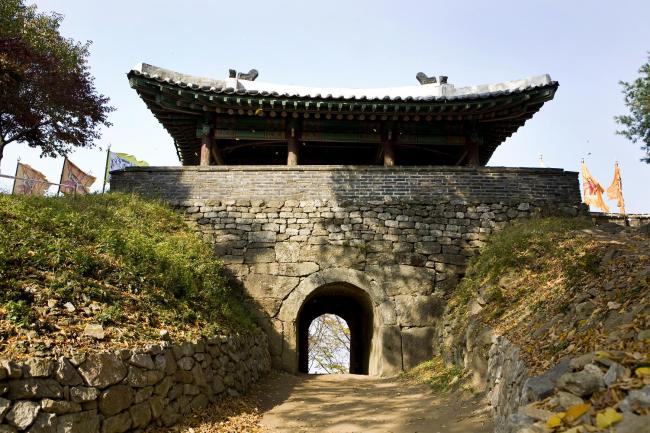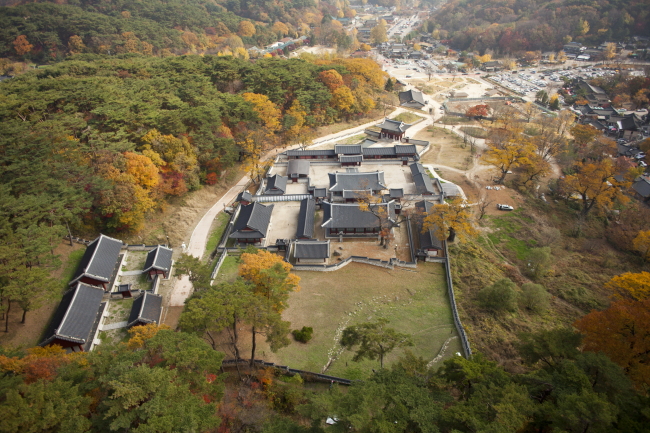
The Western Gate. In 1636, after 47 days under siege, King Injo of Joseon walked through this gate to surrender to the Manchu invaders.
For a long time, Namhansanseong has been one of Koreans’ favorite spots for hiking, driving and eating out.
Nestled in scenic surroundings on the southern outskirts of Seoul and easily accessible by subway, the fortress has been a place to head to break away from the hustle and bustle of the city.
Lesser known to its visitors, however, is that the large circular stone wall and the facilities inside hold an “outstanding universal value” that is worth being inscribed on the UNESCO World Heritage list.
On Sunday, representatives of the U.N. cultural body meeting in Qatar recognized its value, giving it the status regarded as the top honor for monuments, buildings and other natural or cultural sites in the world.
It is now Korea’s 11th item on the much-coveted World Heritage list, joining the ranks of the volcanic island of Jeju, the historic city of Gyeongju and Changdeokgung Palace in Seoul.
“Namhansanseong was a defensive fortress. But it served as an ‘emergency palace’ where the king stayed during the war against the Manchus in the mid-1630s,” said professor Lee Hye-eun of Dongguk University in Seoul.
“Namhansanseong is the only mountain fortress that played such a role.”

Haengjung, a royal palace complex inside the fortress where King Injo stayed during the siege. Cultural Heritage Administration
Standing on the steep ridge of Mount. Namhansan, the fortress is completely encircled by a 11.76-kilometer fortified stone wall.
Inside, there are a royal palace complex, a number of temples and a village where people still live.
Although historical records connect the site to ancient kingdoms of Baekje and Silla in the 7th century, most of the fortress that exists today is from 1624, during the reign of King Injo of Korea’s last ruling dynasty of Joseon.
The king ordered the repair of the fortress, wary of the Manchus who were threatening the Ming Dynasty in China, just north of his land.
In 1636, when the Manchus finally came surging in, King Injo fled to the fortress with his court. He held out there for 47 days, until he finally surrendered to the invaders due to the lack of food, water and supplies. He bowed down to the feet of Hong Taiji, the emperor of the Qing dynasty, nine times and had to send his crown prince to the Qing as a hostage.
The incident, often described as one of the most humiliating moments in Korean history, has been the source of many books, including the 2007 best-selling novel by Kim Hoon.
Attractions
Today, Namhansanseong is most known for its walking trails which offer a scenic view of the southern part of Seoul and Han River. There are five different trails which take from 1 hour to three and a half hours to finish. The longest one takes hikers to walk along the entire 11.76 kilometer stone wall.
Within the walls, there are over 200 buildings. The highlight is a royal palace complex called Haenggung, where King Injo stayed for the 47-day siege. The palace opened its doors to the public in May 2012, after 10 years of repair.
At the fortress’ center lies a small village with traditional houses ― some of them now used as souvenir shops and restaurants.
The easiest way to get there is by subway. Take subway line 8 to Sanseong Station, go out exit 2, and take bus No. 9 to the fortress rotary inside the fortress.
For more information visit http://nhss.ggcf.kr.
By Lee Sun-young (milaya@heraldcorp.com)


![[Exclusive] Korean military set to ban iPhones over 'security' concerns](http://res.heraldm.com/phpwas/restmb_idxmake.php?idx=645&simg=/content/image/2024/04/23/20240423050599_0.jpg&u=20240423183955)




![[Pressure points] Leggings in public: Fashion statement or social faux pas?](http://res.heraldm.com/phpwas/restmb_idxmake.php?idx=645&simg=/content/image/2024/04/23/20240423050669_0.jpg&u=)